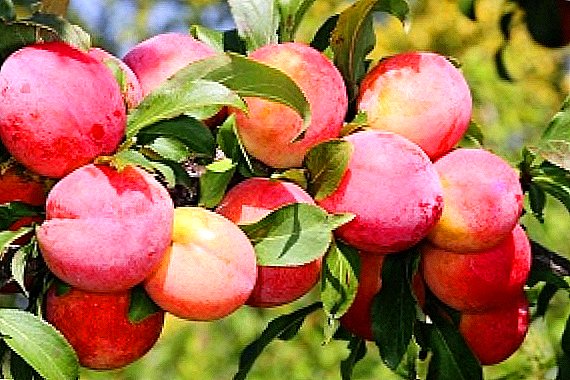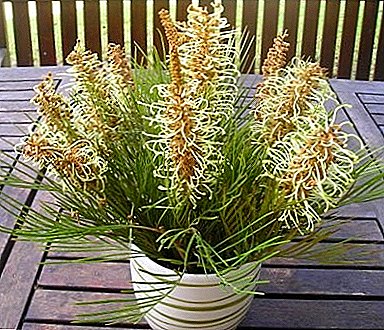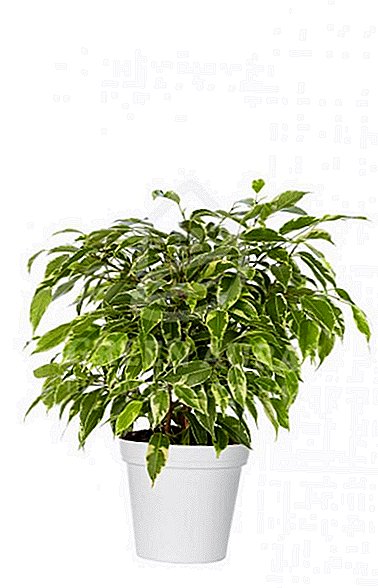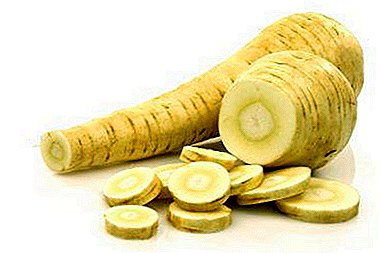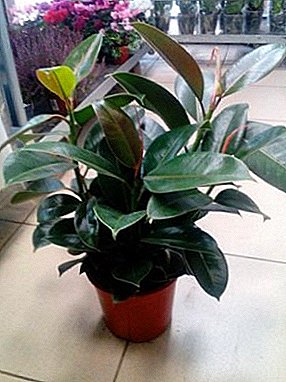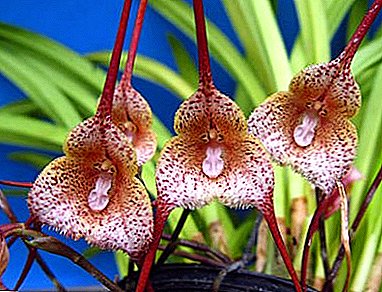
The Dracula Orchid is one of the most unusual species of all known orchids. The flower got its name due to the unusual shape of the inflorescence, resembling a dragon's mouth.
The second name, the monkey orchid, is also a flower that owes its resemblance to the animal's face. Many growers dream to grow such an amazing and exotic flower, rich in shades and able to bloom almost all year round, at home or in the greenhouse. Many subspecies of this genus are named by association by names related to evil spirits: “chimera”, “gorgon”, “nosferatu”, “diabola”.
Description
In the wild, it is found in a humid climate in South and Central America, growing on tree trunks or moving along the surface of the ground. Epiphytes - plants attaching to other plants, but not parasitizing on them, but using them as a support.
 Representatives of this genus have short stems, long arrow-shaped leaves (green or dark green) and a short rhizome (rhizome). There is no pseudobulb, their functions are partially performed by leaflets, which assume a spongy structure, which partially assume the functions of the absent aboveground tubers.
Representatives of this genus have short stems, long arrow-shaped leaves (green or dark green) and a short rhizome (rhizome). There is no pseudobulb, their functions are partially performed by leaflets, which assume a spongy structure, which partially assume the functions of the absent aboveground tubers.
The greatest interest is the unusual flower, very different in different species in shape, size and color. A common feature of all species is the presence of three sepals, collected at the base and forming a semblance of a bowl or hood.
The tips of the petals are stretched out and often on the outgrowths you can observe the hair coat. In the core of the petals is the so-called lip (medial leaflet of the inner circle of the perianth).
Peduncles in monkey orchids are rarely directed downward, in most species they are single-flowered, straight or slightly drooping. Seeds are numerous and small, resembling a spindle.
A number of species (for example, Dracula simia) can bloom year-round.. In natural conditions, flowers are pollinated not only by insects, but also by certain species of small rodents and bats.
History of
The genus Dracula was first described in 1870 by the German botanist Heinrich Gustav Reichenbach, based on a plant found by orchid collector Benedict Roel in the Western Cordillera.
The researcher was amazed at the shape of the flower and called it a "chimera." This flower struck the researcher with its unusual shape, for which he received the name "Chimera".
Initially, representatives of the genus Dracula were assigned to other orchids - Masdevalla, but in 1878 in the light of other finds of the genus were separated. At the end of the 19th century, Dracula was a popular and valuable greenhouse plant in Europe..
Distinctive features
The main difference from other types of orchids is the absence of pseudobulbs (above-ground tubers). The life cycle of a monkey orchid does not provide a period of rest, which is reflected in flowering.
Subgroups and photos
In botany, there are 3 subgenera of the Dracula orchid. See their photos.
Sodiroa is a monotypic subspecies (i.e., having one species).

Xenosia is a monotypic subspecies.

It should be noted that Dracula subspecies includes all other species..

About 15 intergeneric and interspecific hybrids are known.
Bloom
At home, flowering does not depend on the season and, under proper conditions, it may occur at any time of the year and several times a year. In nature, orchid blooms most often occur from June to August..
Care features
With the observance of comfortable growing conditions during the period before and during the flowering period, Dracula does not need special care. When the flower begins to fade independently, it should be removed. If necessary, after flowering, the orchid is transplanted and the plants are kept in dry soil for acclimatization.
Orchid Dracula refers to a revolver type of flowering. On one peduncle, new flowers consistently grow, so it is important to get rid of faded buds in a timely manner.
What to do if the plant does not dissolve?
It is possible to stimulate the appearance of a flower by an artificial temperature difference — at night 5-6 degrees lower (cooling) than at daytime (heating). Or, from May to September, it should be kept outdoors on the balcony, thus providing natural conditions for lowering the temperature at night. You can also use additional lighting in the winter with artificial light devices.
Content: step by step instructions
For the quality of the survival of the plant, the conditions of detention should be close to the natural habitat.
 Choosing a place. The ideal placement side is east or southeast (with diffused light), and the north side will do, but in winter the orchid will need additional lighting.
Choosing a place. The ideal placement side is east or southeast (with diffused light), and the north side will do, but in winter the orchid will need additional lighting.- Soil preparation and pot. Planting is made in transparent pots made of plastic or special wooden baskets. A sphagnum moss is laid on the bottom, on top of which the substrate is laid (a mixture of chopped fern roots, pine bark, charcoal) and the uppermost layer also consists of moss retaining moisture.
- Temperature. Summer temperature content should be no more than +24 degrees, in winter is within + 12-16.
- Humidity. Humidity should be very high - 80-85% and in order to avoid the proliferation of fungi and bacteria, the room must be regularly ventilated.
Important: To increase the humidity, you can use air humidifiers or place a pallet with moist expanded clay near the plant, which, when heated, will evaporate water and locally increase the humidity.
- Lighting. Orchid Dracula grows best in diffused light or partial shade, which corresponds to their usual lower tier of the tropical forest, which is not penetrated by direct sunlight. In case of insufficient lighting, the orchid will not bloom, if it is excessive, burns will appear on the leaves and the plant will begin to dry out.
- Watering. Orchids need regular and sufficient watering. Water is recommended to use soft, better thawed or filtered. The frequency and abundance of irrigation are directly related to the temperature of the content and the amount of light. The plant should evenly absorb and evaporate moisture. At the same time, the water should not stagnate so that the roots do not rot, but too dry soil can lead to the death of the root system.
- Top dressing. Dracula is fertilized during the period of new growth during every third watering. It is best to use top dressing with a special note "for orchids", because the plant is extremely sensitive to the salts usually found in fertilizers.
- Transfer. Frequent transplanting does not require the Dracula Orchid. It is worth replanting if the soil is salted or compacted or the roots have grown too much. The best time for transplantation is in the period of active growth of greenery before flowering.
- Breeding. Usually, this type of orchid is propagated by vegetative means - by dividing the mother bush into parts. The plant is removed from the pot, the roots are cleaned. The incision is made with a sharp knife, sprinkle the cut sites with charcoal and allow the roots to dry. Then the bushes are planted in separate containers.
Diseases and pests
 The Drachula Orchid is prone to a variety of diseases caused by fungi, viruses and bacteria. The most frequent are: fracture, black, gray and root rot.
The Drachula Orchid is prone to a variety of diseases caused by fungi, viruses and bacteria. The most frequent are: fracture, black, gray and root rot.
The infected plant must be isolated from the rest. and process the fungicidal solution until complete recovery.
Orchid also attracts a lot of pests:
- Thrips - insects that are very difficult to get rid of. For the prevention of their appearance, it is advised to spray the plant with infusion of garlic.
- Aphid - feeds on plant sap; it is removed manually using a cotton swab moistened with soapy water.
- Whitefly - most often divorced in the summer and lay their larvae on the leaves, striking the plant. To get rid of these insects will require spraying infusion of calendula and manual removal of larvae with a swab.
Similar flowers
The orchid Dracula can be confused with plants of the genus Masdevalla, the structure and flowering of which are almost identical and of which in the 19th century the genus Dracula was actually distinguished.
- Masdevallia Falcata - One of the most popular plants of this species. It has bright orange or red flowers and elongated flower petals. unlike dracula, the lips are practically not expressed.
- Masdevallia Baby Doll - A hybrid and abundantly flowering plant of bright orange shade. It resembles a small pupa and is suitable for growing in a pot.
- Masdevallia Aquarius - has lemon-yellow flowers with closely planted petals and a cup extended forward. Lips are also not as visible as Dracula’s.
- Masdevallia Discolor - multicolored masdevalia with a rolling color from white to purple with dark streaks. The lips are characteristically pronounced, which makes this look distinguishable only to a professional.


 Choosing a place. The ideal placement side is east or southeast (with diffused light), and the north side will do, but in winter the orchid will need additional lighting.
Choosing a place. The ideal placement side is east or southeast (with diffused light), and the north side will do, but in winter the orchid will need additional lighting.